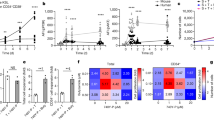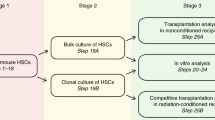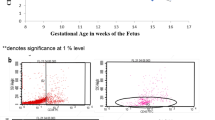Abstract
Cord blood (CB) is an attractive alternative to bone marrow or peripheral blood as a source of transplantable hematopoietic tissue. However, because of the reduced volume, the stem cell content is limited; therefore its use as a graft for adult patients might require ex vivo manipulations. Two systems have been described that identify these stem cell populations in vitro in both mice and humans: (1) the long-term culture-initiating cells (LTC-IC), thus named because of their ability to support the growth of hematopoietic colonies (colony-forming cell (CFC)) for 5–6 weeks when co-cultured on stromal layers; (2) the generation of hematopoietic progenitors (CFC) from stroma-free liquid cultures for extended periods of time, which provides further indirect evidence of the presence of primitive stem cells. Both systems detect largely overlapping but not identical populations of stem cells. Thus the identification of the growth factor requirements for the maintenance and amplification of both systems is relevant. On this basis, analysis of the effects of 18 cytokine combinations on stroma-free liquid cultures of CB CD34+ cells, showed that: (1) after 7- and 14 day-incubation periods, several growth factor combinations expanded the LTC-IC pool to a similar extent; as compared to the LTC-IC, the generation of CFC was not impressive; (2) time-course analysis of the LTC-IC expansion demonstrated that, by extending the incubation period, only a few growth factor combinations, containing FL, TPO, KL and IL6, could support a further, increasingly greater LTC-IC expansion (up to 270 000-fold of the initial value). In similar culture conditions, CFC production underwent continuous expansion, which persisted for over 7 months and reached values of one million-fold of the initial value. The simultaneous presence of FL and TPO was both necessary and sufficient to support this phenomenon. The addition of KL ± IL6 did not appear to substantially modify the extent of LTC-IC expansion; nevertheless, it played an important role in sustaining an even more massive and prolonged output of CFU-GM, CFU-Mk and BFU/CFU-GEMM (up to 100 million-fold); (3) the presence of IL3 was found to be negative, in that it inhibited both the extent of LTC-IC expansion and the long-term generation of CFC. Thus, FL and TPO appear as two unique growth factors that preferentially support the self-renewal of primitive stem cells; the additional presence of KL and IL6 seems to enhance the proliferative potential of at least one subpopulation of daughter stem cells, which may follow three differentiation pathways. Far from being definitive, our data demonstrated that massive stem cell expansion, in cord blood, can be obtained in reasonably well-defined culture conditions. This could represent an initial step towards larger scale cultures for transplantation and gene therapy protocols.
This is a preview of subscription content, access via your institution
Access options
Subscribe to this journal
Receive 12 print issues and online access
$259.00 per year
only $21.58 per issue
Buy this article
- Purchase on Springer Link
- Instant access to full article PDF
Prices may be subject to local taxes which are calculated during checkout
Similar content being viewed by others
Author information
Authors and Affiliations
Rights and permissions
About this article
Cite this article
Piacibello, W., Sanavio, F., Garetto, L. et al. Differential growth factor requirement of primitive cord blood hematopoietic stem cell for self-renewal and amplification vs proliferation and differentiation. Leukemia 12, 718–727 (1998). https://doi.org/10.1038/sj.leu.2401003
Received:
Accepted:
Published:
Issue Date:
DOI: https://doi.org/10.1038/sj.leu.2401003
Keywords
This article is cited by
-
Ex vivo expansion of hematopoietic cells from CD34+ cord blood cells in various culture conditions
Biotechnology and Bioprocess Engineering (2010)
-
Ex vivo expansion of cord blood
Bone Marrow Transplantation (2009)
-
Expansion of human hematopoietic stem cells for transplantation: trends and perspectives
Cytotechnology (2008)
-
Optimal ex vivo expansion of neutrophils from PBSC CD34+ cells by a combination of SCF, Flt3-L and G-CSF and its inhibition by further addition of TPO
Journal of Translational Medicine (2007)
-
Virally mediated MafB transduction induces the monocyte commitment of human CD34+ hematopoietic stem/progenitor cells
Cell Death & Differentiation (2006)



